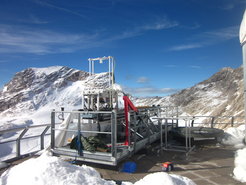New insights on tiny cloud droplets
Since 2014, scientists at the Max Planck Institute for Dynamics and Self-Organization (MPIDS) in Göttingen have been studying the behavior of tiny cloud droplets at the Schneefernerhaus Environmental Research Station (UFS). Their aim is to significantly improve the prediction of precipitation. The ‘Seesaw’ - a device equipped with the latest technology that records the drops three-dimensionally – was installed for this purpose. The results of the first measurements have now been published in the journal 'Review of Scientific Instruments' and promise a major step towards improving precipitation forecasting.
Seesaw is the name of the device that makes it possible to measure the activities and processes within the clouds. The system is based on a box equipped with three high-speed cameras. These are able to move together with the prevailing wind speed in the cloud and thus track and record the path of individual cloud droplets. "The special feature of our setup and measurement method is that we are not only able to measure the instantaneous position of the droplets in 3D at 25,000 frames per second, but also accurately can determine their absolute size," explains Prof. Eberhard Bodenschatz, head of the study and director at MPIDS. Together with computer calculations and laboratory experiments, it will subsequently be possible to predict the behavior of the droplets in clouds and thus significantly improve weather forecasting.
An innovtive and complex setup

Cloud droplets can be so small that they are invisible to the human eye. Only after a large droplet has formed from many small cloud droplets it does eventually fall to earth as precipitation. This process of droplets melting together is called collision. It is highly complex and depends on many different factors, which is why laboratory experiments are not always sufficient for understanding the processes. Therefore, in order to understand the dynamics of the droplets accurately, it is indispensable for scientists to conduct their studies directly in the clouds. For these investigations, typically instruments mounted on airplanes or helicopters are used. However, their drawback lies within their inherent motion, as these instruments do not allow each droplet to be tracked at the correct speed. To bypass this problem, the team from MPIDS eventually developed the Seesaw and installed it on the tower of the UFS on the slope of the Zugspitze. The research station is particularly well suited for such investigations due to its location at an altitude of 2650 m, since it is often shrouded in clouds being Germany's highest research station. In addition, there is usually a constant wind direction there. This also facilitates the adjustment of the camera speed to the wind movement.
First results after intense preparations
After the initial installation of the Seesaw, the instrument had to be tested and adjusted over several years before the first measurements could be taken. The harsh climatic conditions at high altitude and the processing of the large amounts of data required a lot of time and improvements from the scientists; finally, as of 2017, the first measurements of the droplets could be performed. "We are happy that after such intensive preparations, the system works as planned and the first measurements were performed," Jan Moláček, lead scientist in the project, is pleased to say. And Prof. Eberhard Bodenschatz adds, "I am glad that this investment has paid off and will pay off scientifically in the course of the next measurements for a long time to come."
The first measurement results and the experimental setup have now been published in the journal 'Review of Scientific Instruments' (https://aip.scitation.org/doi/10.1063/5.0065806) and promise to be a big step forward in researching the behavior of cloud droplets and thus improving weather forecasting.
